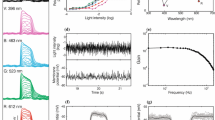Summary
ERG amplitude facilitation, observed in the eye ofAtta sexdens after light adaptation, was studied as a function of duration and intensity of adaptation, of dark interval between adapting and test stimuli, and of level of steady background illumination. Results show that sensitivity facilitation in this eye cannot be regarded as a minor effect since it covers a 2 log unit range, the same as that obtained for conditions that produce sensitivity reduction. Maximum facilitation occurs with short and intense light adaptation. The time span of the effect is close to 2 min, and its maximum amplitude may be attained up to 20 s after light adaptation. Increase in background illumination gradually erases facilitation. However, the facilitated response is less sensitive to background illumination than the dark adapted response. Long durations of light adaptation cause ERG decrease, or inhibition. A comparison of these two end results of light adaptation suggests that they arise from different processes, perhaps with distinct origins.
Similar content being viewed by others
References
Autrum, H., von Zwehl, V.: Zur spektralen Empfindlichkeit einzelner Sehzellen der Drohne (Apis mellifica). Z. vergl. Physiol.46, 8–12 (1962)
Bader, C.R., Baumann, F., Bertrand, D.: Role of intracellular calcium and sodium in light adaptation in the retina of the honey bee drone (Apis mellifera, L.). J. gen. Physiol.67, 475–491 (1976)
Barlow, H.B.: Dark and light adaptation: psychophysics. In: Handbook of sensory physiology, Vol. VII/4, Visual psychophysics (eds. D. Jameson, L.M. Hurvich). Berlin-Heidelberg-New York: Springer 1972
Bartlett, N.R.: Dark adaptation and light adaptation. In: Vision and visual perception (ed. C.H. Graham), New York: Wiley 1965
Baumann, F.: Slow and spike potentials recorded from retinula cell of the honey bee drone in response to light. J. gen. Physiol.52, 855–875 (1968)
Benolken, R.M., Russell, C.J.: Dissection of a graded visual response with tetrodotoxin. In: The functional organization of the compound eye (ed. C.G. Bernhard) Oxford: Pergamon 1966
DeVoe, R.D.: Dual sensitivities of cells in wolf spider eyes at ultraviolet and visible wavelengths of light. J. gen. Physiol.59, 247–269 (1972)
Dowling, J.E.: Discrete potentials in the dark-adapted eye of the crabLimulus. Nature (Lond.)217, 28–31 (1968)
Dudek, F.E.: The visual response from the compound eye ofOncopeltus fasciatus: effects of temperature and sensory adaptation. J. Insect Physiol.21, 517–528 (1975)
Dudek, F.E., Koopowitz, H.: Adaptation and temporal characteristics of the insect visual response. J. comp. Physiol.82, 33–46 (1973)
Enroth, C.: The mechanism of flicker and fusion studied on single retinal elements in the dark adapted eye of the cat. Acta physiol. scand.,27. Suppl. 100 (1952)
Fuortes, M.G.H., Hodgkin, A.L.: Changes in time scale and sensitivity in the ommatidia ofLimulus. J. gen. Physiol.172, 239–263 (1964)
Giulio, L., Lucaroni, A.: “Test flash” interaction in the electroretinographic response of the compound eye. Experientia (Basel)23, 542–543 (1967)
Granit, R.: Receptors and sensory perception. New Haven: Yale University Press, USA 1955
Granit, R., Riddell, H.A.: The electrical responses of light- and dark-adapted frog's eyes to rhythmic and continuous stimuli. J. Physiol. (Lond.)81, 1–28 (1934)
Hanani, M., Hillman, P.: Adaptation and facilitation in the barnacle photoreceptor. J. gen. Physiol.67, 235–249 (1976)
Hartline, P.H., Lange, G.D.: Optic nerve responses to visual stimuli in squid. J. comp. Physiol.93, 37–54 (1974)
Matin, L.: Critical duration, the differential luminance threshold, critical flicker frequency, and visual adaptation: a theoretical treatment. J. opt. Soc. Amer.58, 404–415 (1968)
Naka, K., Kishida, K.: Retinal action potentials during dark and light adaptation. In: The functional organization of the compound eye (ed. C.G. Bernhard) Oxford: Pergamon 1966
Normann, R.A., Werblin, F.S.: Control of retinal sensitivity. I. Light and dark adaptation of vertebrate rods and cones. J. gen. Physiol.63, 37–61 (1974)
Piper, H.: Über die Netzhautströme. Arch. Anat. Physiol. (Lpzg.), 85–132 (1911)
Ruck, P.: Dark-adaptation of the ocellus inPeriplaneta americana: a study of the electrical response to illumination. J. Insect Physiol.2, 189–198 (1958)
Ruck, P., Jahn, T.L.: Electrical studies on the compound eye ofLygia occidentalis dana (Crustacea, Isopoda). J. gen. Physiol.37, 825–849 (1954)
Shaw, S.R.: Decremental conduction of the visual signal in barnacle lateral eye. J. Physiol. (Lond.)220, 145–175 (1972)
Srebro, R., Behbehani, M.: Light adaptation in the ventral photoreceptor ofLimulus. J. gen. Physiol.64, 166–185 (1974)
Stratten, W.P., Ogden, T.E.: Spectral sensitivity of the barnacle,Balanus amphitrite. J. gen. Physiol.57, 435–447 (1971)
Ventura, D.F.: The effect of adaptation level on critical flicker frequency. Ph. D. Dissertation, Columbia University New York 1968
Ventura, D.F., Martinoya, C., Bloch, S., Puglia, N.M.: Visual sensitivity and the state of adaptation in the antAtta sexdens. J. comp. Physiol.110, 333–342 (1976)
Author information
Authors and Affiliations
Additional information
Supported by a grant from Fundação de Amparo à Pesquisa do Estado de São Paulo, to the senior author (Contract n∘ 71/1141)
With a Fellowship from Fundação de Amparo à Pesquisa do Estado de São Paulo (N∘ 74/388)
We wish to express our appreciation to Henrique Fix for his editorial assistance, and to Celia Jablonka for laboratory help.
Rights and permissions
About this article
Cite this article
Ventura, D.F., Puglia, N.M. Sensitivity facilitation in the insect eye. J. Comp. Physiol. 114, 35–49 (1977). https://doi.org/10.1007/BF00656807
Received:
Issue Date:
DOI: https://doi.org/10.1007/BF00656807




